
Next to a full biography of Victor Delhez in timeline format, you can also find two special sections here. One with images of a few of the printing blocks that survived. Delhez often made only eight prints of a work before destroying the original printing block, probably to avoid mass printing. This makes his works quite unique because there are only eight prints of each work. A second section is dedicated to the students of Victor Delhez who was a professor at the Academy of Fine Arts part of the National University of Cuyo in Argentina and during his classes he inspired many artists.
1902
March the 16th 1902
Victor Delhez…
was born in Antwerp, Belgium on March the 16th 1902.

Hotel des Sports
He was the seventh and youngest child of Antoine Delhez, who managed a hotel with the name ‘Hotel des Sports’ just across the street of the Central Station in Antwerp. The building does not exist anymore today, it was demolished in the 70’s and replaced by an ugly concrete apartment building.

Hotel des Sports in its glory days
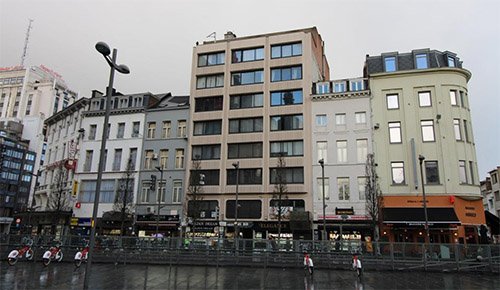
The ugly concrete building of today.
The Delhez family
Antoine Delhez was also one of the first ones in Antwerp to own a car company. Father Delhez was a person you never forgot once you had met him. Small, corpulent and often accompanied by two great Great Danes. Victor Delhez or Fik for short was known as ‘the son of the Hotel des Sports.’
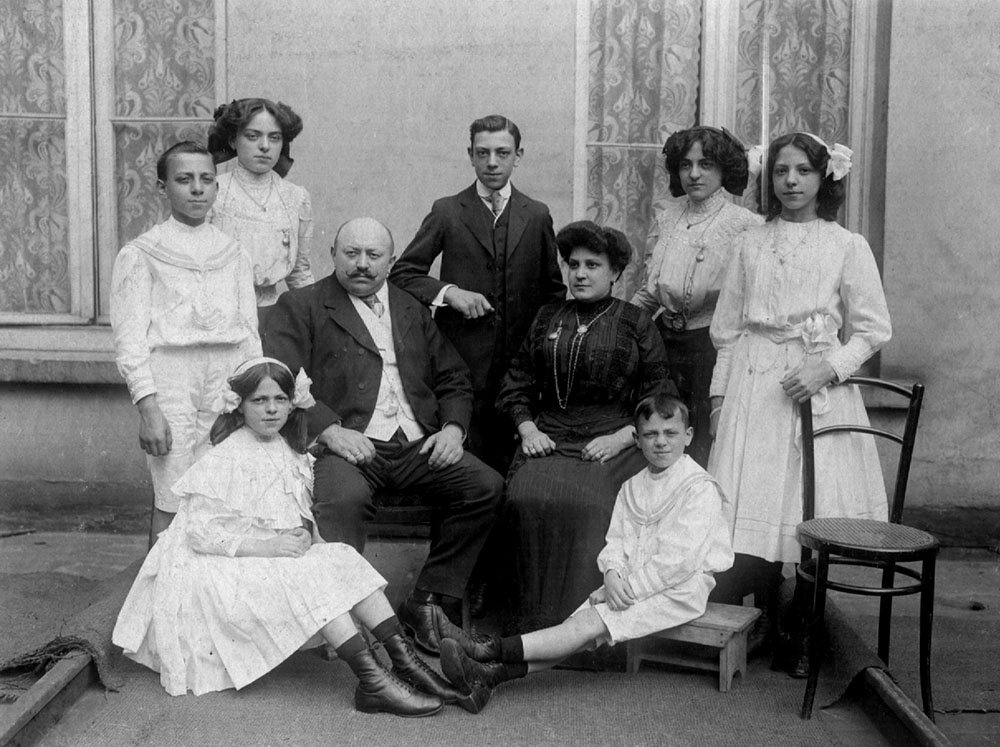
Antoine Delhez
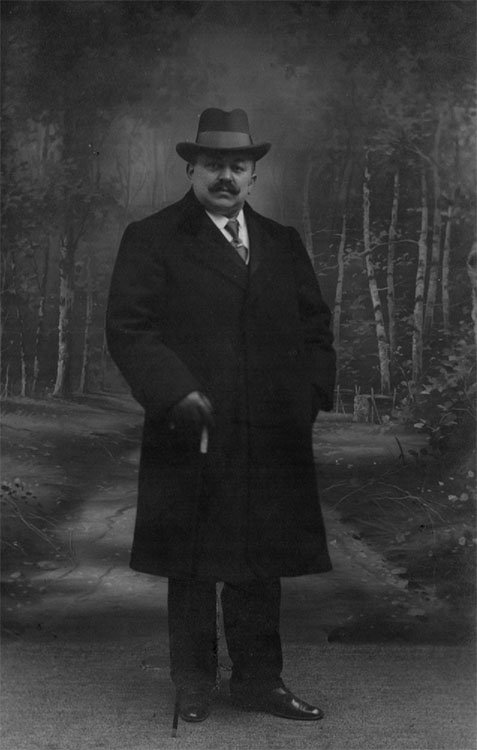
1914
1914
Schoolyears
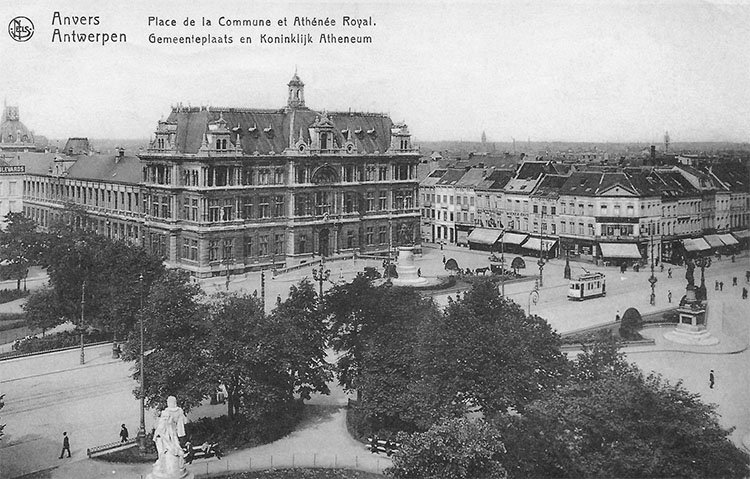
Victor Delhez attended school at the Royal Atheneum in Antwerp, but due to the outbreak of the First World War, he had to move abroad for his secondary studies, more specifically to the Ecole Lafayette in Paris and the Acland School in London.
1916 – 1918
Royal Academy of Antwerp
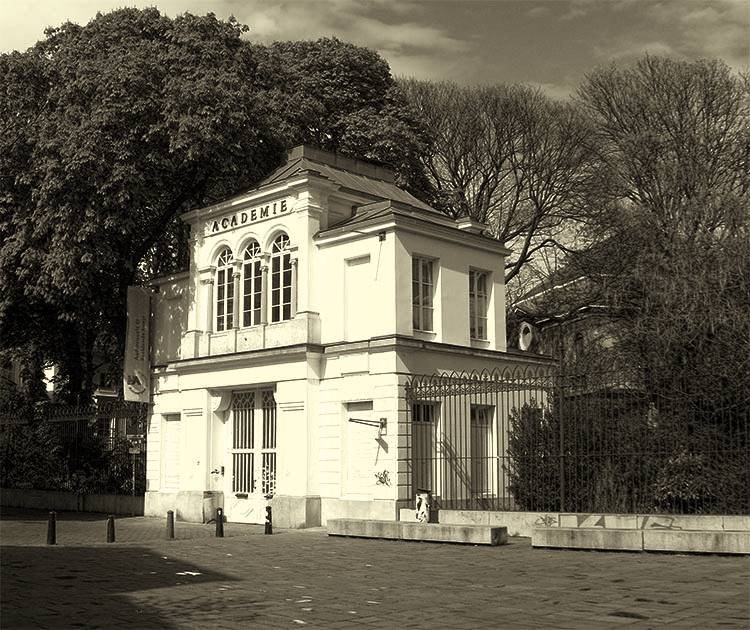
When he returned and during his final years in the scientific department at the Royal Atheneum of Antwerp, Delhez also took lessons in architecture, drawing and painting at the Royal Academy in Antwerp. He was a student of the well-known painter Felix Gogo and architect Pol Berger.
1918
1918
First works
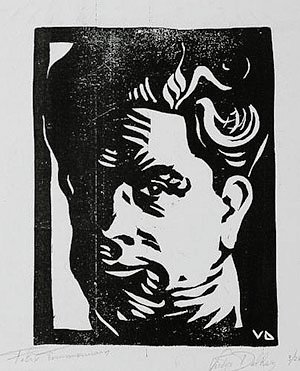 His first collection of linos, ‘Tien Vlaamse Koppen’, (Ten Flemish Faces, five from Delhez, five from Mauritz Lambreghts) was published in 1918. These works are very basic, but clearly announces a promising talent.
His first collection of linos, ‘Tien Vlaamse Koppen’, (Ten Flemish Faces, five from Delhez, five from Mauritz Lambreghts) was published in 1918. These works are very basic, but clearly announces a promising talent.

1919
1919
Ship draftman

His free-spirited life came to an end in 1919 when he was recruited as a ship draftsman at the Cockerill shipyard in Hoboken, a suburb of Antwerp. However, that job did not give him the satisfaction he was looking for.
1919 – 1923
University years
 He insisted on his (wealthy) parents until he was allowed to study at the University of Leuven. Four years later, he graduates as an agronomist with chemistry as his primary subject.
He insisted on his (wealthy) parents until he was allowed to study at the University of Leuven. Four years later, he graduates as an agronomist with chemistry as his primary subject.
1923
1923
Military service
 In 1923 Victor Delhez fulfills his military service and then his father involves him in the management of the car company where he sells cars and runs the repair shop.
In 1923 Victor Delhez fulfills his military service and then his father involves him in the management of the car company where he sells cars and runs the repair shop.
 During this period he also remains active as an artist and makes literary contributions to newspapers, magazines and works on a series of woodcuts.
During this period he also remains active as an artist and makes literary contributions to newspapers, magazines and works on a series of woodcuts.
1924
October the 11th 1924
Fate strikes
 On October the 11th of 1924 fate struck mercilessly. His father and mother die from the consequences of a traffic accident in Braine-le-Comte a Walloon municipality located in the Belgian province of Hainaut. Safety on board of cars in those days was not as we know it today, so in the event of a collision it didn’t take much to make it disastrous.
On October the 11th of 1924 fate struck mercilessly. His father and mother die from the consequences of a traffic accident in Braine-le-Comte a Walloon municipality located in the Belgian province of Hainaut. Safety on board of cars in those days was not as we know it today, so in the event of a collision it didn’t take much to make it disastrous.
Antoine Delhez & Marie Thérèse Diels
 Antoine (52) dies on the spot, his wife Marie-Therese (51) and Delhez’s mother lives three more days and then dies in the hospital. Victor Delhez’s carefree future is shattered due these events.
Antoine (52) dies on the spot, his wife Marie-Therese (51) and Delhez’s mother lives three more days and then dies in the hospital. Victor Delhez’s carefree future is shattered due these events.
1925
1925
First publication

In 1925 Delhez’s first series of woodcuts he started working on in 1923 is published with a foreword by Professor Dr. Jozef Muls.
The big decision
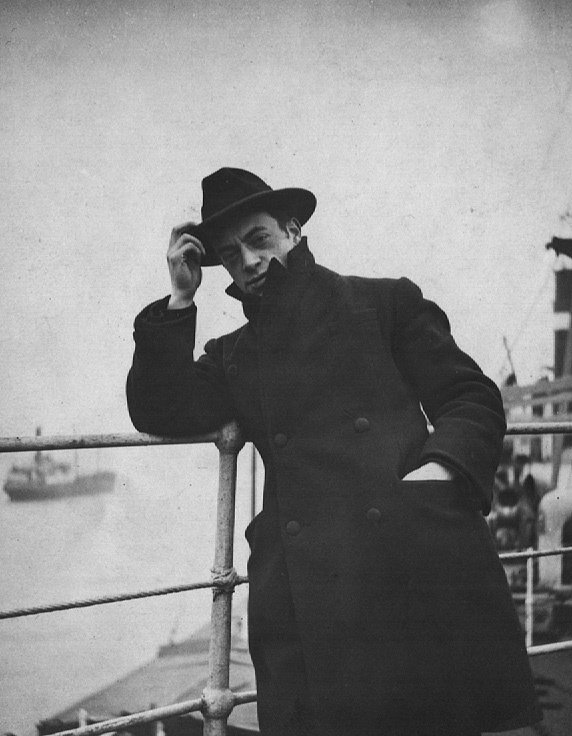
Was it due the death of his parents or his creative drive for adventure, who can tell, but that same year Victor Delhez takes the surprising decision to emigrate to South America, more specifically to Argentina.
1926
1926
Buenos dias Buenos Aires

In 1926 Victor Delhez arrives in Buenos Aires after an endless boat trip. He is in a foreign country, without family and money. He goes to the Belgian embassy, but there they say “Mr. Delhez, if I were in your place, I would take the first boat back home.” Delhez replied with a quote from the well-known French general Mac Mahon: “J’y suis, j’y reste” which means “I’m here and I’m staying here.” Delhez kept his word, because he stayed in South America for the remaining days of his life.
1926 – 1933
Seven years of Buenos Aires
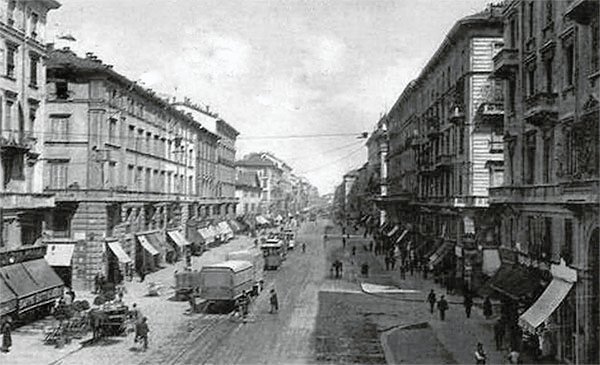
Delhez stays in Buenos Aires for seven years. He had a modest job in an harbor office, worked as an illustrator for an architect, decorated a bar with futuristic paintings, makes publicity drawings, paints, engraves, photographs and has several assignments as decorator for various clients.
He does not get rich from it. He barely earns five pesos per week which is about € 0.06 / 0,067 $ today. For a moment he dreams of setting up an agricultural company, but that is a stillborn idea. After a few years, he and two other artists became known as ‘Los tres locos’, the three fools.
1932
1932
Les fleurs du mal
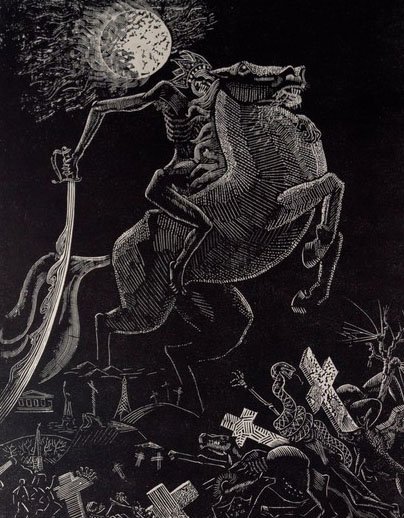 Despite everything, Delhez doesn’t give up and keeps working on his future. He reads a lot and so he becomes fascinated by ‘Les Fleurs du Mal’, (The Flowers of Evil) a volume of poetry by the French poet Charles Baudelaire. This results in a total of 60 woodcuts, of which he exhibited the first 30 in Buenos Aires in 1932, followed by another 30 engravings.
Despite everything, Delhez doesn’t give up and keeps working on his future. He reads a lot and so he becomes fascinated by ‘Les Fleurs du Mal’, (The Flowers of Evil) a volume of poetry by the French poet Charles Baudelaire. This results in a total of 60 woodcuts, of which he exhibited the first 30 in Buenos Aires in 1932, followed by another 30 engravings.
The works received considerable acclaim, not the least from various leading art critics. The ‘Les Fleur du Mal’ series makes Delhez a local celebrity, but it doesn’t make him richer. He can barely make a living.
1933
1933
Don’t cry for me Argentina
 In 1933 Delhez accepts the invitation of Edgard Ernalsteen, another Antwerp citizen from Borgerhout – who just like Delhez, had taken the leap into the unknown – to accompany him to Bolivia.
In 1933 Delhez accepts the invitation of Edgard Ernalsteen, another Antwerp citizen from Borgerhout – who just like Delhez, had taken the leap into the unknown – to accompany him to Bolivia.
1934 – 1937
Road to Cochabamba
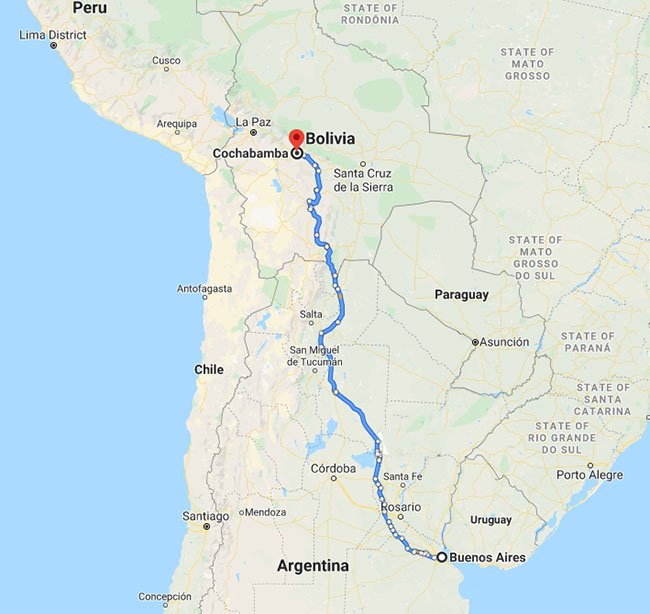
Ernalsteen bought an estate in Suticollo about 26km (16 miles) southwest of the town of Cochabamba. Delhez would stay in the peaceful Cocaraya Valley for a total of four years.
1934
February 1934 – June 1937
The first Gospels
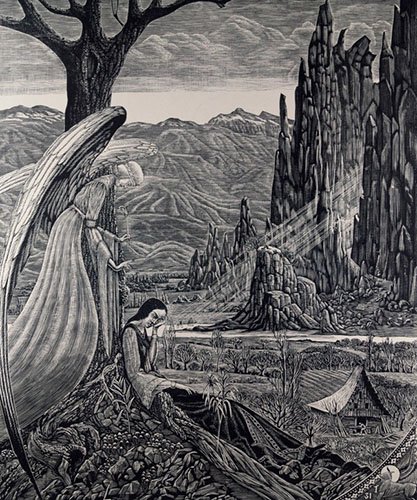
Delhez takes the first steps in what would become his magnum opus, the realization of the more than 100 engravings on the subject of the Gospels. A remarkable series of engravings, not least because of his friendship with the Quechua Indians, through which Christ and the stories from the Gospels can be seen in the typical Bolivian landscape. In Bolivia he completes the first 42 engravings of this series.
Quechua people
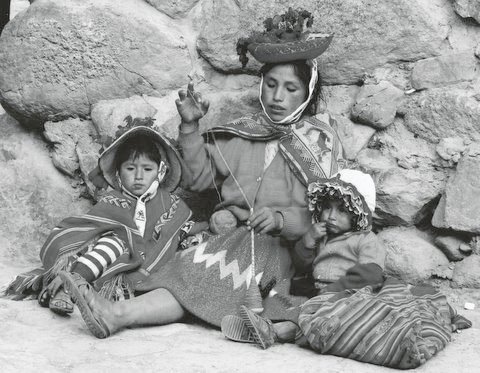
Quechua (or Quecha) people refers to any of the indigenous people of South America who speak the Quechua languages. Although most Quechua speakers are native to the country of origin, there are some significant populations living in Ecuador, Bolivia, Chile, Colombia and Argentina. The various Quechua dialects (already spoken by the Incas) are in some cases so different that no mutual understanding is possible. They are today with about 11 million of which 1.9 million live in Bolivia.
1935
July 1935 – December 1936
A dreamer tales
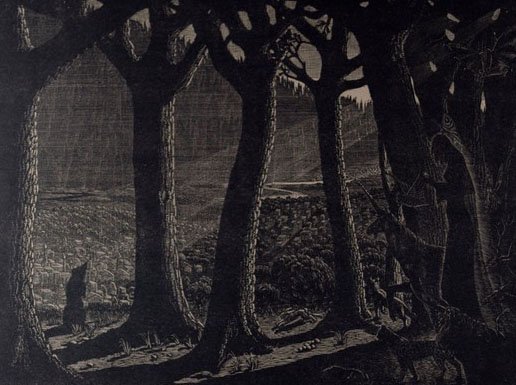
Delhez is very productive. In addition to numerous other engravings, he also made the series ‘A Dreamer Tales’ by Lord Dunsany during this period. A series of 21 engravings inspired by the works of Lord Dunsany.
Lord Dunsany
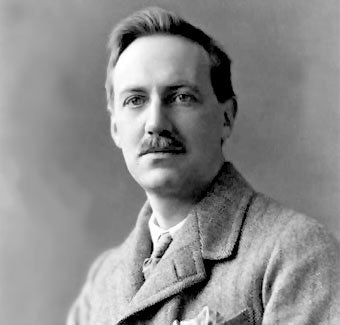
Lord Dunsany (1878 – 1957) whose full name and title was Edward John Moreton Drax Plunkett, 18th Baron of Dunsany, was an Anglo-Irish writer and dramatist who published more than ninety books during his lifetime, and inspired writers such as H. P. Lovecraft, J.R.R. Tolkien, Arthur C. Clarke, Jack Vance and many others.
1937
1937
My name is Delhez…Victor Delhez

The aftermath of the Chaco war in Paraguay (1932- 1935) is also felt in Bolivia and the police suspects Victor Delhez of being an Argentine spy who prints counterfeit money with his printing press. Delhez had to leave the country and moved to Santiago de Chile (Chile) where he continued to work on the Gospel series and a few other works.
Head over heels to Chile

1938
1938
Return to Argentina
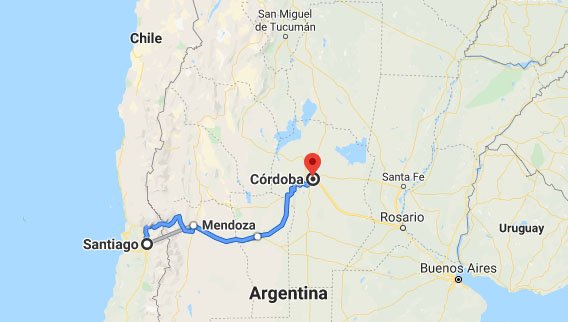
In 1938 Victor Delhez returns to Argentina, but exchanges Buenos Aires for the more inland city of Cordoba.
Totoral days
 Delhez works most of the time in the summer house of his friend Rodolfo Araoz Alfaro and his wife Maria del Carmen (a sculptor herself) in a town called ‘Villa General Mitre’, but locally known as Totoral (and today as Villa del Totoral). Alongside other works Delhez continues working on the Gospel series here.
Delhez works most of the time in the summer house of his friend Rodolfo Araoz Alfaro and his wife Maria del Carmen (a sculptor herself) in a town called ‘Villa General Mitre’, but locally known as Totoral (and today as Villa del Totoral). Alongside other works Delhez continues working on the Gospel series here.
Rodolfo Araoz Alfaro
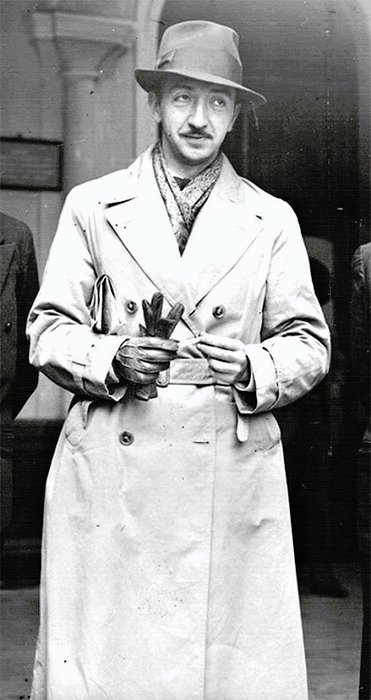 Rodolfo Aráoz Alfaro (1901 – 1968) was a lawyer who was a member of the Argentine Communist Party. He was in charge of defending many political and union prisoners and held the position of attorney general. Although he had a different political opinion than Delhez, they were close friends.
Rodolfo Aráoz Alfaro (1901 – 1968) was a lawyer who was a member of the Argentine Communist Party. He was in charge of defending many political and union prisoners and held the position of attorney general. Although he had a different political opinion than Delhez, they were close friends.
1939
April 1939
Dance of death
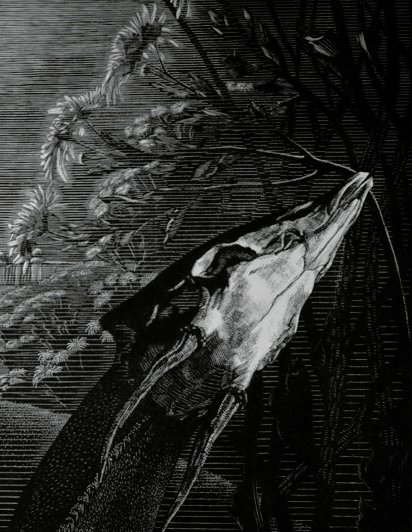 In April 1939 Victor Delhez starts with a new series of engravings called ‘Dance Of Death’ (also known as Dance Macabre). In Totoral he would only complete seven of the 36 engravings of this series.
In April 1939 Victor Delhez starts with a new series of engravings called ‘Dance Of Death’ (also known as Dance Macabre). In Totoral he would only complete seven of the 36 engravings of this series.
Professor Delhez

In that same year Delhez becomes a professor of graphic techniques at the University of Cuyo (Mendoza) where he would educate students for many years in the art of engraving. Works of his students can be seen here (opens in a new tab).
1940
1940
Last move
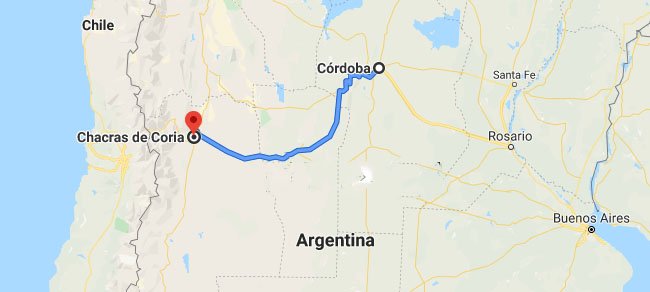
Victor Delhez moved for the last time in 1940, the year in which Europe was on fire due the Second World War. He finds his permanent home in Chacras de Coria a suburb of Mendoza about 100 km from the Chilean Border with the Andes Mountains in the backyard.
October 1940
The Dostoyevsky series

In October 1940 Delhez starts with yet another new series of engravings. The Dostoyevsky series would become a three part series with a total of 83 engravings based upon the works of the Russian writer Fyodor Mikhailovich Dostoyevsky. He starts with a first series of sixteen engravings called ‘Small preparatory series from novels from before 1861.’
Fyodor Mikhailovich Dostoyevsky
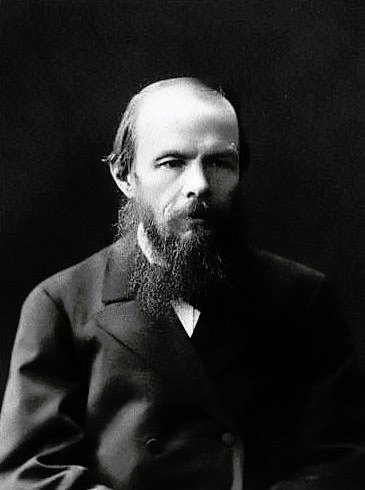
Fyodor Mikhailovich Dostoyevsky (1821 – 1881), was a Russian novelist, short story writer, essayist and journalist. Dostoevsky’s literary works explore human psychology in the troubled political, social, and spiritual atmospheres of 19th-century Russia, and engage with a variety of philosophical and religious themes. His most acclaimed works include Crime and Punishment (1866), The Idiot (1869), Demons (1872), and The Brothers Karamazov (1880). Dostoyevsky’s body of works consists of 12 novels, four novellas, 16 short stories, and numerous other works. Many literary critics rate him as one of the greatest psychological novelists in world literature.
1941
October 1941
Study without support
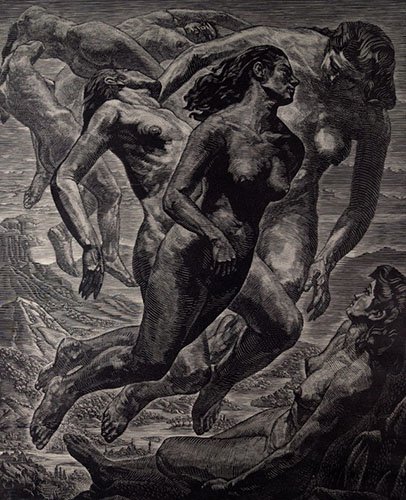 In October 1941 Victor Delhez creates in the Sortiment series the first of seven engravings with as title ‘‘Study without support’. Delhez called these sometimes ‘Torbellinos’ and it’s a series consisting exclusively of compositions with nudes.
In October 1941 Victor Delhez creates in the Sortiment series the first of seven engravings with as title ‘‘Study without support’. Delhez called these sometimes ‘Torbellinos’ and it’s a series consisting exclusively of compositions with nudes.
1942
1942
Marriage with Liske

In 1942 Victor Delhez married the musically inclined Alicia de San Pedro, whom he called ‘Liske’. She would give him two daughters and two sons.
October 1942
The insulted and humiliated
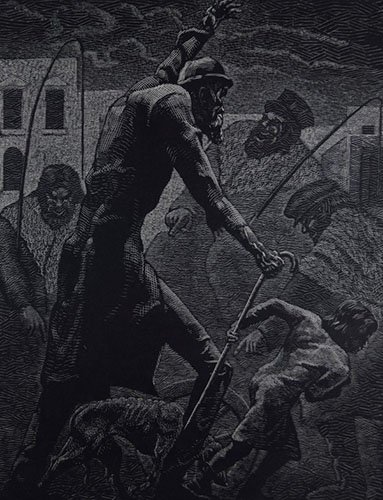 In October of that same year Delhez starts with the second part of 24 engravings of the Dostoyevsky series inspired by the book ‘The Insulted and Humiliated’ (1861).
In October of that same year Delhez starts with the second part of 24 engravings of the Dostoyevsky series inspired by the book ‘The Insulted and Humiliated’ (1861).
1944
1944
The first son
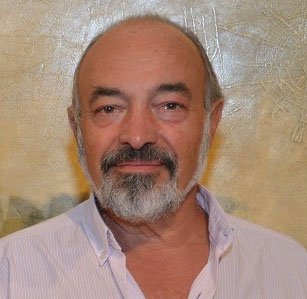 Victor Delhez’s first son, Mario Julio Regis Delhez is born. We only have a recent photo of him, and in our opinion he looks a lot like his father. This event also results in the first engraving in the Line Engraving series.
Victor Delhez’s first son, Mario Julio Regis Delhez is born. We only have a recent photo of him, and in our opinion he looks a lot like his father. This event also results in the first engraving in the Line Engraving series.
Los Quatro Evangelios
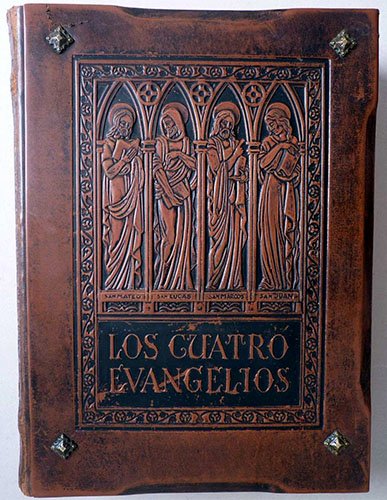
Guillermo Kraft Buenos Aires publishes the first edition of ‘Los Quatro Evangelios’. More than 600 pages, written in Spanish and luxuriously bound in leather with gold on the sides. It features 90 engravings of the Gospel series.
1945
September 1945
Crime and punishment
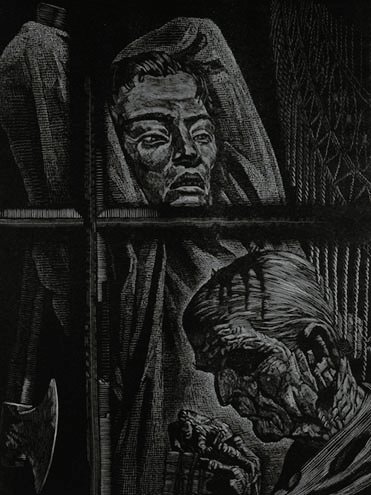 In September 1945 Victor Delhez starts with the final part of the Dostoyevsky series. By 1947 it would result in 43 engravings in total inspired by the book Crime and Punishment. (1866)
In September 1945 Victor Delhez starts with the final part of the Dostoyevsky series. By 1947 it would result in 43 engravings in total inspired by the book Crime and Punishment. (1866)
1946
1946
The second son
 In 1946 Victor Delhez’s second son Alberto Chris (Cristian) Delhez is born. Unfortunately we do not have a picture from him in our family archive from his childhood on which we can identify him, so also a recent photo from him, with again a great resemblance to his father.
In 1946 Victor Delhez’s second son Alberto Chris (Cristian) Delhez is born. Unfortunately we do not have a picture from him in our family archive from his childhood on which we can identify him, so also a recent photo from him, with again a great resemblance to his father.
This event also results in a work in the Line Engraving series dedicated to the birth of this second son. Chris passed away on October 20, 2022.
Delhez is busy

In 1946 Delhez delivers only one new engraving in the Dance Of Death series and a few ones in the Sortiment series, but that’s probably because he’s very busy with the 32 engravings he creates for the final part of the Dostoyevsky series (Crime and punishment).
1947
1947
Start of the apocalypse
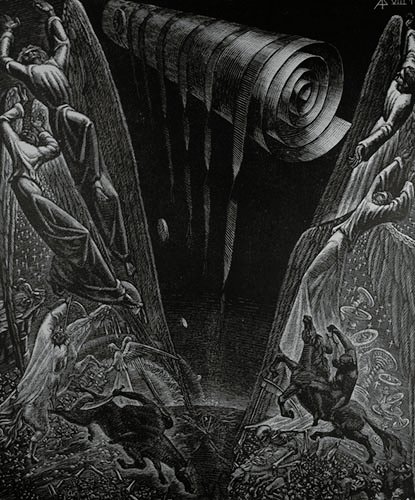
Victor Delhez starts with another new series based upon the Book of Revelation. These works are generally known as ‘The Apocalypse series’ and are widely regarded as the best series of engravings Delhez has made. Many call it a true masterpiece of 20th century graphic art. Usually he makes woodcuts, but for this series he works on copper plate.
June 1947
Final Dostoyevsky
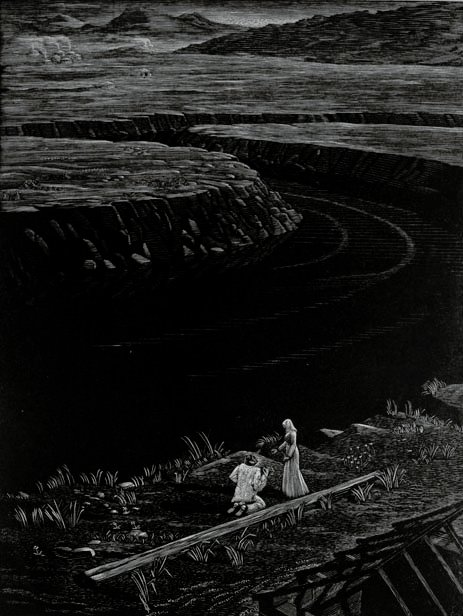 In June 1947 Delhez finishes the ‘Crime and punishment’ part of the Dostoyevsky series with the ten last engravings of the series.
In June 1947 Delhez finishes the ‘Crime and punishment’ part of the Dostoyevsky series with the ten last engravings of the series.
1948
December 25th 1948
Architecture and nostalgia
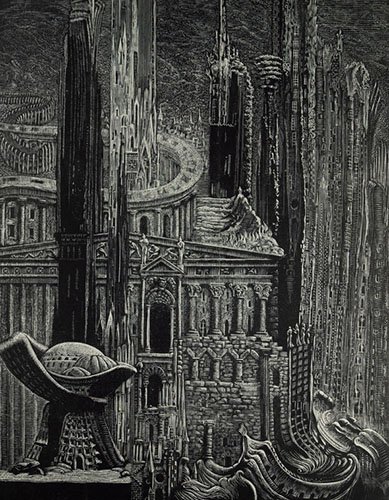
On Christmas day Victor Delhez starts with another series called ‘Architecture and nostalgia’. This series is part of the Sortiment series and at this time we don’t know how many he exactly made of this sub-series. We are aware of 26 works, but probably there’re more.
The last gospels
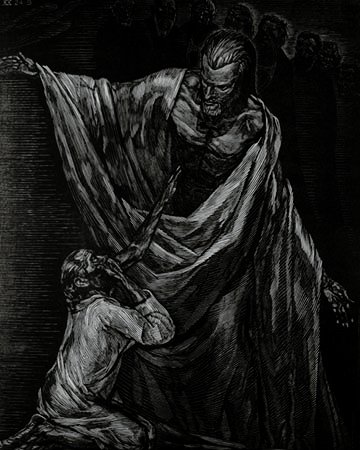 This year, and four years after the last one, Delhez finishes five additional engravings of the Gospel series. Those five are not in the book published by Guillermo Kraft in 1944.
This year, and four years after the last one, Delhez finishes five additional engravings of the Gospel series. Those five are not in the book published by Guillermo Kraft in 1944.
Next to this he creates several works for the Sortiment series, finishes a second engraving in the Apocalypse series and five in the Dance of Death series.
1949
1949
Just a few works
 Victor Delhez only creates a few works for the Sortiment series, only one engraving for the Apocalypse series (The Four Horsemen) and five in the Dance of Death series.
Victor Delhez only creates a few works for the Sortiment series, only one engraving for the Apocalypse series (The Four Horsemen) and five in the Dance of Death series.
1950
1950
The first daughter
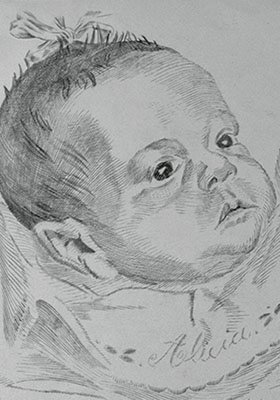 This year Victor Delhez becomes father again. He welcomes his first daughter, Alicia Gloria del Carmen Delhez. As usual there is a work dedicated to this event in the Line Engraving series.
This year Victor Delhez becomes father again. He welcomes his first daughter, Alicia Gloria del Carmen Delhez. As usual there is a work dedicated to this event in the Line Engraving series.
Architecture and nostalgia III
 Next to that Delhez finishes a third engraving in the Architecture and nostalgia series, one in the Dance of Death series and a few in the Sortiment series.
Next to that Delhez finishes a third engraving in the Architecture and nostalgia series, one in the Dance of Death series and a few in the Sortiment series.
1951
1951
Sabbatical year ?
 It looks like Victor Delhez is taking a sabbatical year. Besides of a few works in the Sortiment series, no new engravings are created for the Dance of Death or Apocalypse series.
It looks like Victor Delhez is taking a sabbatical year. Besides of a few works in the Sortiment series, no new engravings are created for the Dance of Death or Apocalypse series.
1952
1952
Second daughter
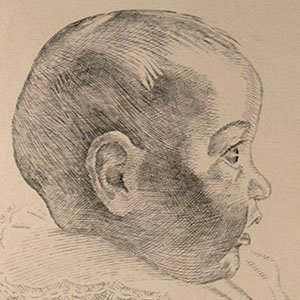 Claudia Monica Caroll Delhez is born, Victor Delhez’s fourth child and second daughter. Again there is a special engraving to celebrate this (last) child in the Line Engraving series.
Claudia Monica Caroll Delhez is born, Victor Delhez’s fourth child and second daughter. Again there is a special engraving to celebrate this (last) child in the Line Engraving series.
A very productive year
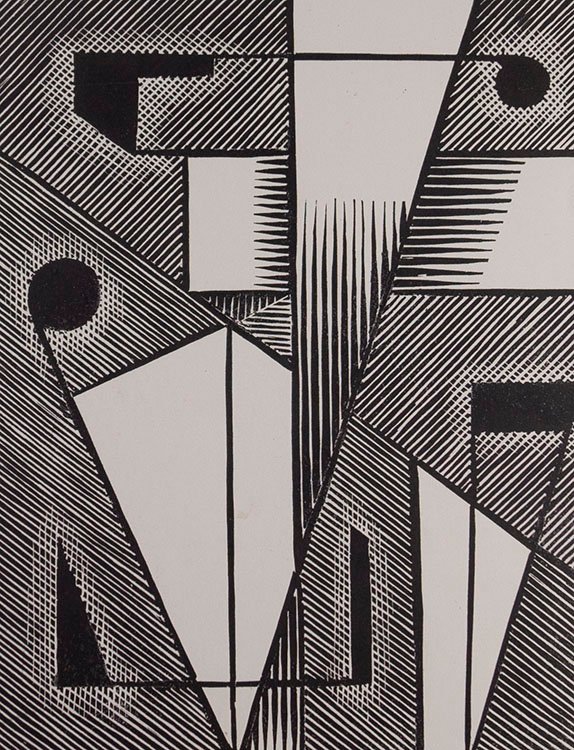
After his sabbatical year Delhez suddenly becomes very productive. He finishes just under a hundred works in the Sortiment series. No new engravings in the Dance of Death and Apocalypse series however. Delhez focuses mainly on smaller works and sub-series (mostly in a very abstract style) like Rondo and engravings with very strange titles like ‘Triangular contempt in three four pentagon’ or ‘Tectonic harmony with light horizontal stresses and deep vertical chords’ are created.
1953
1953
Delhez takes it easy again
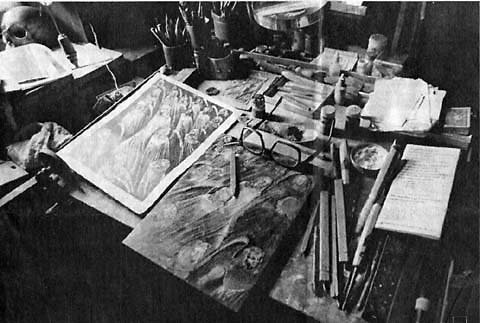
After a very productive year Delhez takes it easy again this year. Just a few engravings in the Sortiment series are finished. Despite that number four in the Architecture and nostalgia series is not yet finished, (that would take until 1955) he finishes number five in the series.
1954
1954
Microscherzino series
 Victor Delhez starts with a small sub-series in the Sortiment series called Microscherzino. Very small engravings (6,5 x 9 cm) in color. Only seven would be created between 1954 and 1956.
Victor Delhez starts with a small sub-series in the Sortiment series called Microscherzino. Very small engravings (6,5 x 9 cm) in color. Only seven would be created between 1954 and 1956.
Architecture and nostalgia VI
 Delhez also starts working on number six of the Architecture and nostalgia series.
Delhez also starts working on number six of the Architecture and nostalgia series.
1955
1955
Three times Architecture and nostalgia
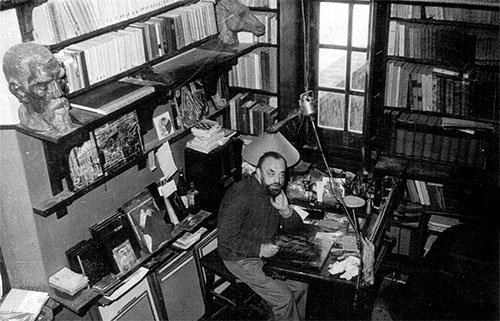
This year Victor Delhez finishes three engravings in the Architecture and nostalgia series (numbers seven, eight and nine) and he finishes number 31 in the Dance of death series, which he had already started in 1951.
1956
August the 4th 1956
The Breda exhibition
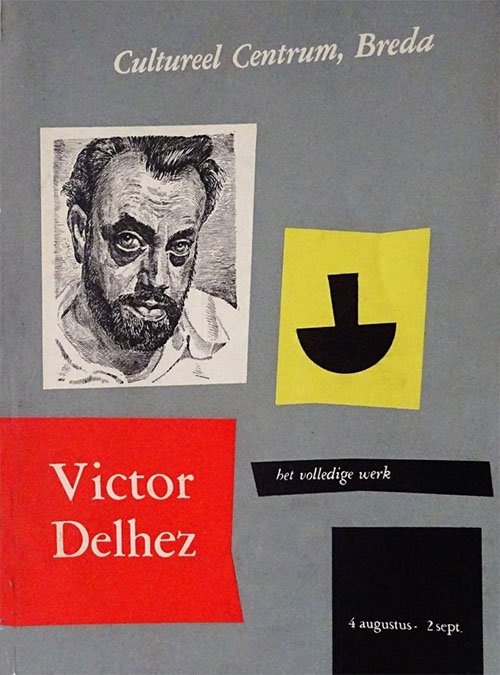
A Victor Delhez exhibition opens in Breda (The Netherlands). Most information in this biography and in the Works for sale section of this website comes from the catalog of that exhibition, the so called Breda catalog. This also means that we don’t have any detailed information anymore about what Delhez exactly has created after 1956.
The Breda catalog
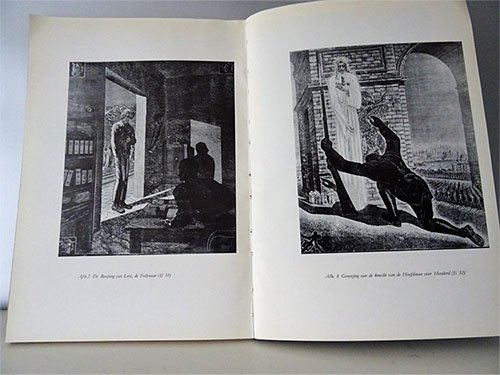
We know he finished the Dance of Death series in 1956 and kept working on the Architecture and nostalgia series that was probably finished somewhere between 1957 and 1960. He also completed the Apocalyps series with a total of 49 engravings. Delhez must have created other works too, probably for the Sortiment series, but at this moment we don’t have information about how many works he has created after 1956 and what the titles of the works are.
1960
1960
Return to Antwerp
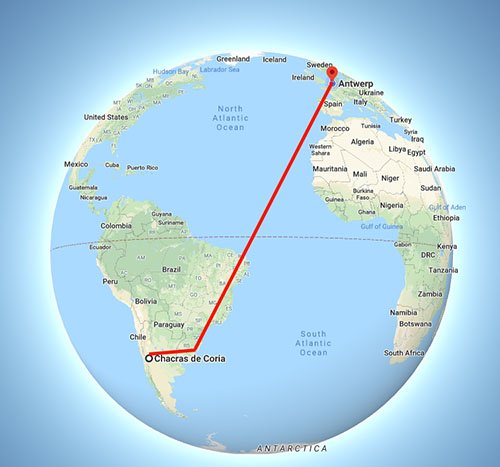
The most important achievement in 1960 is the fact Victor Delhez returns to Antwerp (this time by plane, not with a boat) for the first time in 35 years. Roguish as he is, he answers the question of a journalist who asks him “Do you find there is a lot changed in Antwerp since your departure in 1925?” with the words : “Not much has actually changed, except that our cathedral is no longer hidden behind scaffolds.”
Visiting family
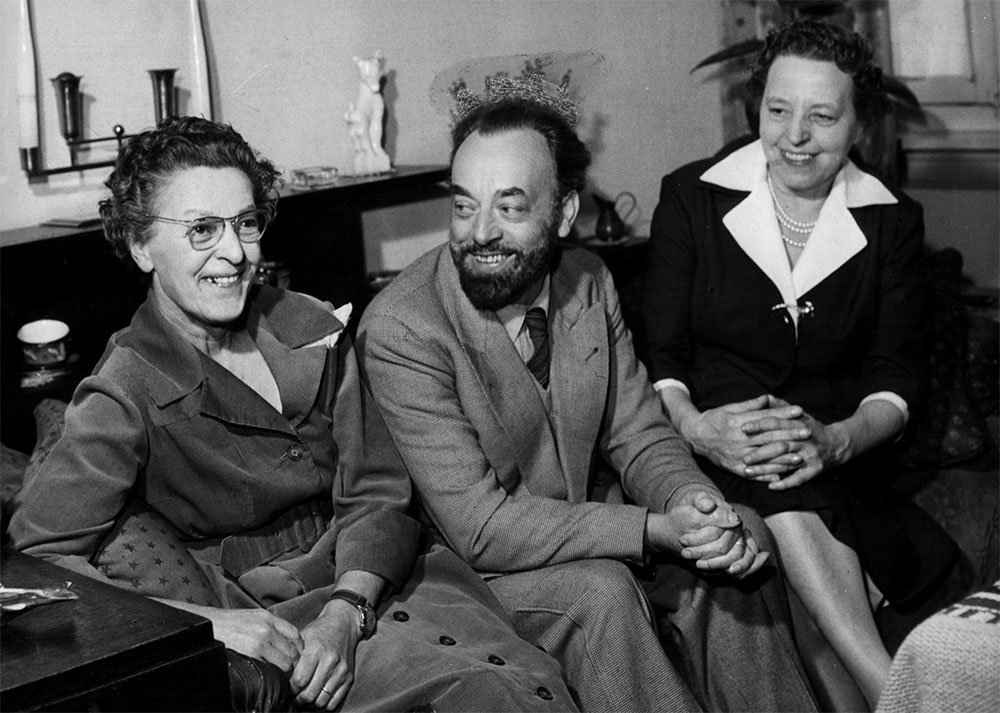
Of course Delhez also visits his brothers and sisters, of which Jeanne and Alice – who still live in the building at 25 Lamorinièrestraat, where Antoine Delhez’s car company was located – are the best known, not least because they are the “local agents” of Victor Delhez who manage his work for Europe. Of the eight prints of each engraving, four always remain in Argentina and four are sent to the sisters in Belgium.
25 Lamorinièrestraat
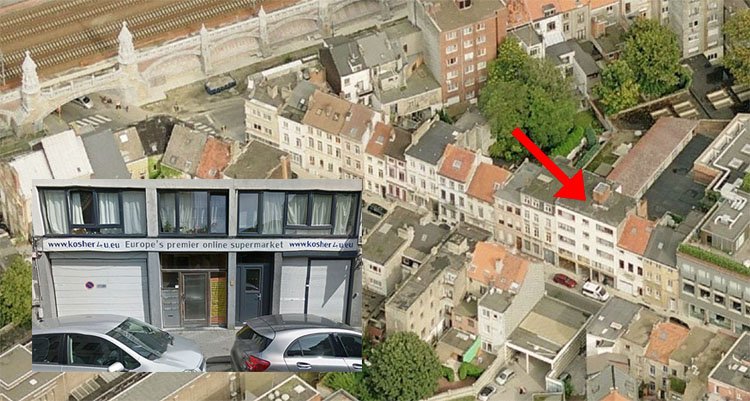
25 Lamorinièrestraat, today. (picture 2017)
Michel Seuphor
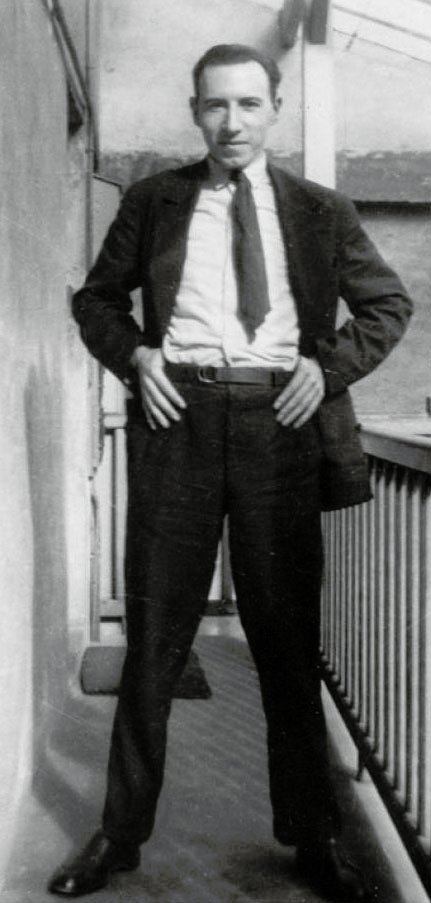
There is an exhibition in Antwerp as well as in Cologne, that mainly focuses on his abstract works and Delhez also stays in Paris for a while, where he can stay in the house of the Belgian painter Michel Seuphor, (1901 – 1999) who at that time was often called ‘The Pope of the abstract.’
1965
1965
Delhez in Japan
 In 1965 there is the first major Victor Delhez exhibition in Japan. Previously there had been smaller exhibitions in that country, but this one is just a little bit bigger. All expenses and publicity are paid by “Mainichi”, the largest Japanese daily newspaper with a daily circulation of 5,000,000 copies. We have no indications he actually has been in Japan himself, but his works did.
In 1965 there is the first major Victor Delhez exhibition in Japan. Previously there had been smaller exhibitions in that country, but this one is just a little bit bigger. All expenses and publicity are paid by “Mainichi”, the largest Japanese daily newspaper with a daily circulation of 5,000,000 copies. We have no indications he actually has been in Japan himself, but his works did.
Delhez in the USA

Delhez also becomes popular in the USA. 276 engravings were donated (with the knowledge and approval of the artist) to the Manatee Junior College in Bradentown, Florida by Gustave Delhez, an uncle of Victor who lived in the USA, and were exhibited permanently in the New Art Building. Today the place is known as the State College of Florida, Manatee-Sarasota, and they still own those 276 works. Apart from that, Victor Delhez’s works have also been exhibited at the Smithsonian in Washington and the Metropolitan Museum of Art in New York.
1966 – 1980
1966 – 1980
Later years

The Belgian agents
 On this photo you can see the two sisters of Delhez (on the left Jeanne and on the far right Alice who had the nickname ‘Tatty’) and in the middle his niece Mariette Geuens – Huybrechts. As said before, the two sisters and later his niece and her husband Fernand Huybrechts always have been ‘the local agents’ of Victor Delhez in Europe.
On this photo you can see the two sisters of Delhez (on the left Jeanne and on the far right Alice who had the nickname ‘Tatty’) and in the middle his niece Mariette Geuens – Huybrechts. As said before, the two sisters and later his niece and her husband Fernand Huybrechts always have been ‘the local agents’ of Victor Delhez in Europe.
1981
1981
The last return
 21 years after his last visit, Victor Delhez returns to Antwerp (in the company of his wife Liske and two of her sisters) for the last time. He was invited by the organisation ‘Vlamingen in de wereld vzw’ (Flemish people in the world asbl). Delhez travels to Antwerp because there is a celebration with an exhibition for his 80th birthday, which the City of Antwerp, the Province of Antwerp and the Ministry of Dutch Culture are supporting.
21 years after his last visit, Victor Delhez returns to Antwerp (in the company of his wife Liske and two of her sisters) for the last time. He was invited by the organisation ‘Vlamingen in de wereld vzw’ (Flemish people in the world asbl). Delhez travels to Antwerp because there is a celebration with an exhibition for his 80th birthday, which the City of Antwerp, the Province of Antwerp and the Ministry of Dutch Culture are supporting.
A new book
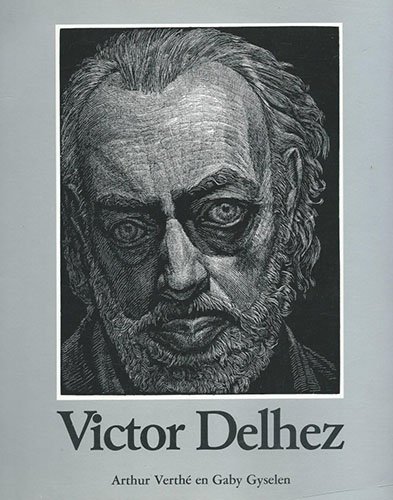 The exhibition in Antwerp also results in an accompanying book by Arthur Verthé – who had already visited Delhez in Argentina – and Gaby Gyselen.
The exhibition in Antwerp also results in an accompanying book by Arthur Verthé – who had already visited Delhez in Argentina – and Gaby Gyselen.
1985
January the 4th 1985
Victor Delhez dies
 Victor Delhez died on the 4th of January 1985, in Mendoza, Argentina. The exact cause (presumably just of old age, he was 82 years old) and burial place is unknown.
Victor Delhez died on the 4th of January 1985, in Mendoza, Argentina. The exact cause (presumably just of old age, he was 82 years old) and burial place is unknown.
Present
Present day
Delhez lives forever
 Victor Delhez will never be forgotten. This website also has the purpose in keeping Victor Delhez alive and making sure that he and his works will never be forgotten. Just type his name into Google and you will be amazed at the number of search results. The last time we did this, there were over 560,000!
Victor Delhez will never be forgotten. This website also has the purpose in keeping Victor Delhez alive and making sure that he and his works will never be forgotten. Just type his name into Google and you will be amazed at the number of search results. The last time we did this, there were over 560,000!
Street in Chacras de Coria
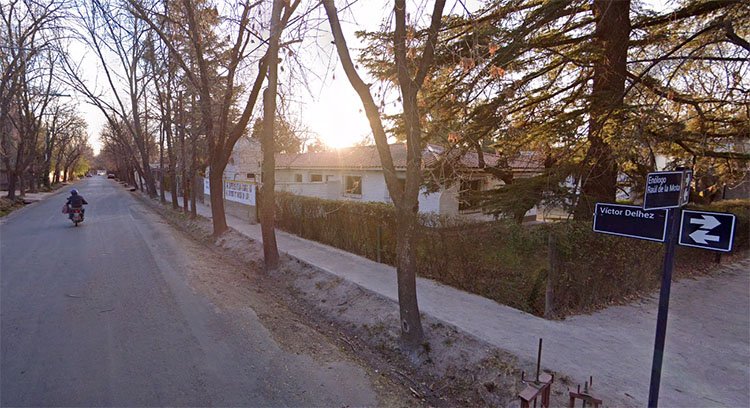 In Chacras de Coria, a street is named after him. A dead end, but still with quite a few houses. On, Google we even found a house for sale in the street for $ 650,000, so certainly not a neighborhood for poor people.
In Chacras de Coria, a street is named after him. A dead end, but still with quite a few houses. On, Google we even found a house for sale in the street for $ 650,000, so certainly not a neighborhood for poor people.
Meanwhile in Antwerp…
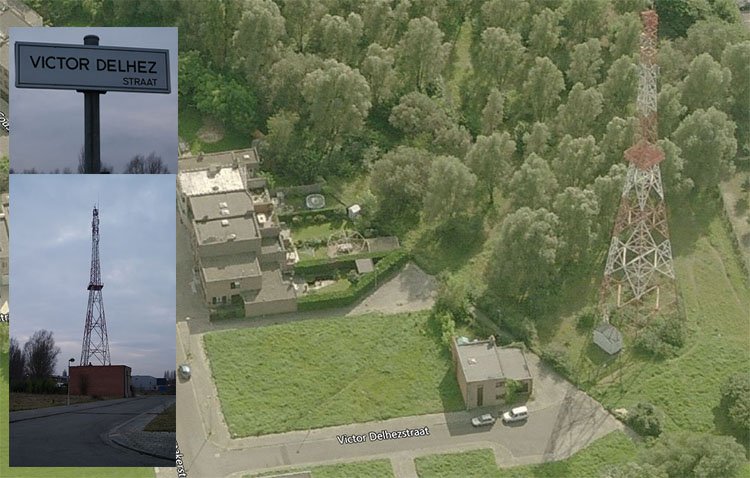
In Belgium Victor Delhez never received the recognition he actually deserved…not even today. In Belgium he’s almost forgotten (but we’re going to work on that !) On the left-bank side of Antwerp, hidden somewhere – you really have to search to find it – a small desolate street with only one house in it (and until a few years ago also a huge transmission tower) has been named after him. In our opinion Victor Delhez should at least deserve a (small) square somewhere in the city of Antwerp…maybe one day, who knows?